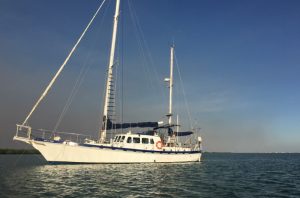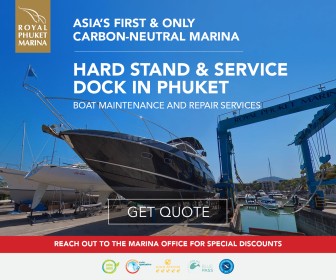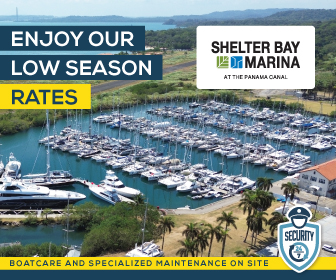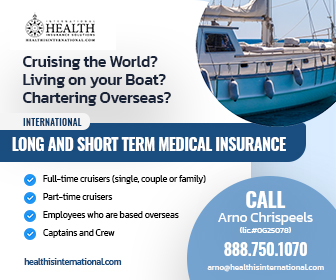A Circumnavigation Under Power
Robert Burn fulfilled a circumnavigation from 2016 to 2018 in his 16.7m Bermudan ketch rigged motor sailer. Wai-O-Tira.The complete voyage was carried out under power and this report contains extensive details of all the fuelling aspects of doing so.
Published 6 years ago


- Wai-O-Tira
Departing Australia
Our voyage got off to a good start when we topped up our tanks at Baileys Fuel Wharf in Darwin, where we arranged to take on duty-free fuel at AU$0.80 per litre.
The 2016-2018 circumnavigation by our steel ketch was continuously assisted by a reliably efficient Gardner 6LW engine turning an N&B three-bladed 32” propeller. The fuel capacity for our 16.7 metre yacht is 3,500 litres, giving us good range, which allowed us to have some choice in our fuel suppliers.
Motoring Techniques
The engine was kept working with about 100rpm for every knot of speed. It does an engine no good at all to run it without any load. Cruising on a 20 knot reach we made about 8 knots at 800rpm with our 30 ton vessel, using 2 liters per hour. The average fuel consumption was 3 liters per hour for 6,250 engine hours, and so we used about 20,000 liters and traveled around 50,000 nautical miles, for a total AU$18,000 cost.
A few times we needed to motor into headwinds, particularly in the narrow strictures of the Red Sea, a distance of about 1,000nm from Djibouti to the Sinai.
We also found it useful to be able to steam into the strong Meltemi of the Aegean, and the various calms to be found in the Banda and Sulu Seas, and also around the capricious Pacific.
Whilst our vessel is fitted with solar panels and a wind generator, it was convenient to have ample power for refrigeration, the microwave oven, the autopilot and other various appliances and equipment, particularly when underway. With the long keel, the prop wash assisted with course keeping.
Buying Fuel
Some countries allow you to take on duty-free fuel after you have cleared customs so that this fuel is consumed outside the local jurisdiction. There is generally a minimum order of 1,000 liters, such as in Apia, W. Samoa, and needs some legwork going from Customs to the Harbour Master then to the fuel distributor for delivery. Payment may be a credit card, or often cash. The Marina in Bali takes a fee for using their facilities even though Benoa Harbour is a mess. They also appoint an agent, so they collect extra fees for another family friend. This was prevalent in Asia and South America. They were more honest in their methods in Europe, such as in Kannakale ($1.20) in Turkey and Kotor ($0.78) in Montenegro.
There was a variety of currencies in the Caribbean, but the real price was fairly consistent, at around AU$1.15 per liter. We were fortunate to find cheaper fuel when larger quantities were required such as in dirty Djibouti (AU$0.80), clean Kotor and charming Nuku Hiva ($0.58).
In some places, such as Trincomalee, the street price can be much cheaper than the marina bunker price. Here we bought four 205 liter steel drums and filled them in town at AU$0.78
A taxi truck delivered them to the wharf, where we had to roll them down to the boat as the officials wouldn’t let the taxi onto the wharf. The taxi then took the empty drums as delivery payment.
Most fueling points we targeted, as we heard they were cheaper; however some were disappointing such as Varna (AU$1.05), and Puerto Lucia in Ecuador (AU$0.91), where the fuel was double the price that the sardine fishing fleet was paying at the same pumps
Refueling
The most memorable refueling operation was in Nuku Hiva at the Total fuel wharf. There is a constant heavy swell sweeping around this bay, which made it almost impossible to go alongside the wharf. So we anchored off and then backed in and got a couple of heavy nylon lines ashore. We took on 1200 liters of fuel in 20 minutes. It was intended that we take on much more, but I didn’t wish to spill fuel from the venting wing tanks in the engine-room.
Fuel Contamination
Many fellow seafarers we met were most concerned about fuel quality. We never had any issues in this regard, maybe because all the providers we used had high turnover. Whenever it was available we used the fuel additives, due to biocidal concerns. This is due to a type of bacteria living in the condensate water at the bottom of the tank, which feeds on and breaks down the fuel above it, resulting in a brown sludge referred to as “rust”. It congests fuel filters and pumps. It can contaminate other tanks, so do not transfer it between tanks or to other vessels. The bacteria can be incubated in tropical climates, or where modern common rail engines circulates excess fuel through injectors for cooling purposes.
Filtering
Most diesel fuel nowadays is refined to US MilSpec, as required for engine warranty compliance. Diesel fuel, or gas oil, is generally filtered in two or three stages, the first stage generally incorporates a water separator. The second can be a duplex arrangement, allowing filters to be changed whilst the engine is running. The third stage is commonly rated at 5 microns filtration, so as to ensure the cleanest possible fuel for modern multi-point injectors.
Diesel Additives
Whilst the world is awash with cheap crude oil, and refined to a uniform standard, the crude comes from a variety of fields, with varying sulfur, or ash content. The sulfur can be useful as a lubricant, but when burnt and mixed with other combustion by-products, creates sulphuric acid. To counter this phenomenon, lubricating oils are made alkaline and have a TBN or Total Base Number, to reduce internal corrosion of the engine. Fuel from Arabia tends to be sweeter, with a lower ash content, whilst fuel from Asia or Singapore is higher. This means that engine oils should be changed regularly, more so in the Eastern hemisphere due to higher sulfur content.
Maintenance
On commercial vessels, there is normally an oil sampling and testing regime to profile oil contaminants and engine wear. Where there are multiple engines in an installation, then this regime becomes more cost-effective. For the recreational yachtsman, this is more tenuous, so a regular maintenance schedule is more prudent. Oil changes are normally done between 250 and 500 engine hours, or every 3 months; whichever occurs first. Oil does much for your engine: it cools, cleans, and lubricates it.
Attention is drawn to these aspects of engine maintenance because fuel vendors normally supply a range of quality lubricants, and also have facilities for receiving and recycling used oil, whilst many marinas and yacht clubs, lamentably, do not. Many yacht owners are happy to use cheaper, automotive multigrade engine oils. Marine engines generally perform with higher loads, with much longer duty cycles; in my case weeks at a time. For this reason I use SAE-30 Monograde oil. It is slightly more expensive, but the lubrication qualities are far superior at normal operating temperatures. It better protects my reliable Gardner engine.
Robert Burn
SY Wai-O-Tira
The opinions expressed in this article are the author’s own and do not reflect the view of Noonsite.com or World Cruising Club.
Related to following destinations: Australia, Benoa, Brisbane, Bulgaria, Canakkale, Cape Verdes, Curacao, Dardanelles, Darwin, Djibouti, Ecuador, French Polynesia, Grenada, Indonesia, Jordan, Kotor, Marquesas, Mindelo (Sao Vicente), Montenegro, Northern (Barlavento) Group, Northern Territory (Australia), Nuku Hiva, Phuket Island, Prickly Bay, Puerto Lucia (La Libertad), Pulau Langkawi, Queensland, South / Central Indonesia - Bali, Sri Lanka, Thailand, Turkey, Varna, West Coast (Malaysia), Western Samoa
Related to the following Cruising Resources: Circumnavigation
Related to the following Services, Goods and Amenities: Fuel, Marine Services








Thanks for your interesting account. If I understand correctly, you did the complete voyage using power. If so, I am sure there are many of us wondering why you used fuel rather than sail whenever it was possible to sail. Perhaps you could explain?
Robert very impressed by your trip. Your fuel consumption is about half what my 6lxb uses? I run 20 ton semi displacement trawler with a 4 blade 38 inch prop. 1000 rpm 6 knots.
Have been toying with the idea of circumnavigation.
Any more you can add would be great.